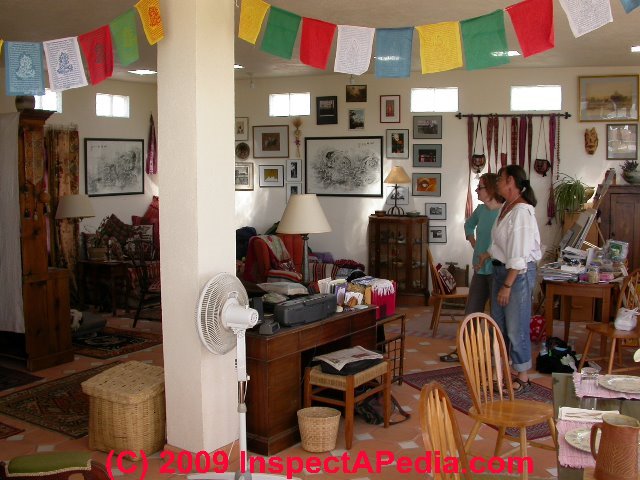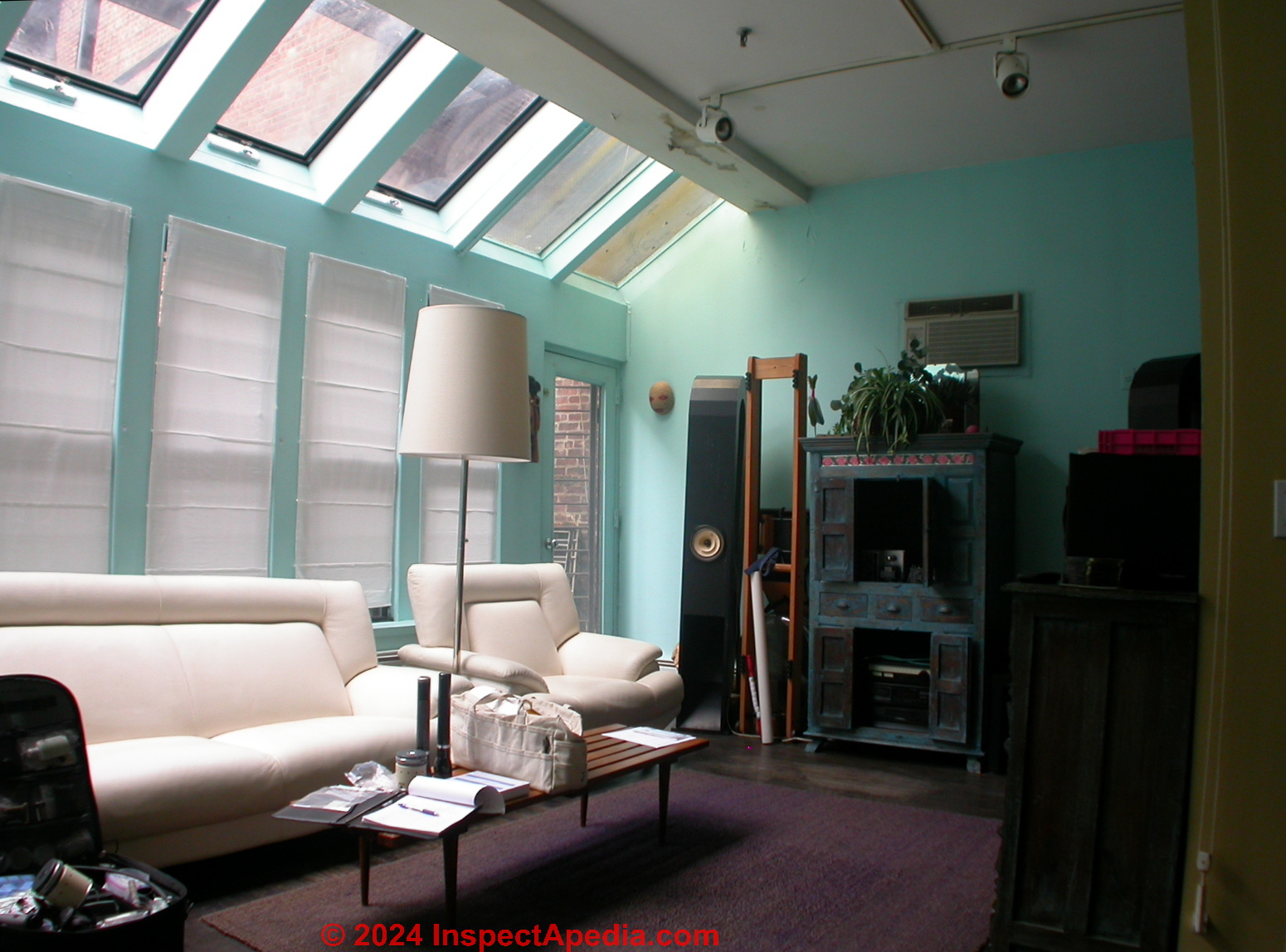 Thermal Mass Wall Finishes for Absorbing & Storing Solar Heat
Thermal Mass Wall Finishes for Absorbing & Storing Solar Heat
- POST a QUESTION or COMMENT about how to choose a final coating or finish material, color, etc. for thermal mass walls and passive solar energy systems
This article discusses the design details, color, coating of a mass wall intended to absorb and store solar heat for a passive solar energy home.
Page top photo: interior of a passive solar home in Mexico.
Notice the small windows around the wall tops, avoiding excessive heat gain in summer. Photos by D Friedman.
Accompanying text are reprinted/adapted/excerpted with permission from Solar Age Magazine - editor Steven Bliss.
InspectAPedia tolerates no conflicts of interest. We have no relationship with advertisers, products, or services discussed at this website.
- Daniel Friedman, Publisher/Editor/Author - See WHO ARE WE?
Coating, Color, Design for Thermal Mass Wall for Passive Solar Design
The question-and-answer article below paraphrases, quotes-from, updates, and comments an original article from Solar Age Magazine and written by Steven Bliss.
Topic: Use of Drywall over Masonry Block Thermal Mass Wall
 Question: what's the impact on thermal mass if we cover a masonry block wall with drywall - glued to the block?
Question: what's the impact on thermal mass if we cover a masonry block wall with drywall - glued to the block?
In a passive solar home I am building, the entire first floor is enclosed by vermiculite-filled, 10-inch concrete block externally insulated by 2-inch thick polystyrene insulating board.
I am inquiring about the efficiency of covering the interior surface of the masonry block thermal mass wall with drywall that would be attached directly to the block by adhesive.
Will solar-gain heat be absorbed by the drywall and thereby conducted to and stored in the underlying masonry wall? -- David Kallett, Pompton Lakes NJ
Photo: solid brick walls of this New York City apartment were covered by glued-on drywall directly bonded to the brick, retaining much of the building's thermal mass.
This apartment is discussed also at PASSIVE SOLAR PERFORMANCE PROBE
Answer:
If the thermal mass walls are intended to absorb and store solar heat, the wall surface should have high absorptance (a dark color) and conductivity that equals or exceeds that of the storage materials themselves (the concrete block) so that heat will flow into the thermal storage wall at least as fast as if the wall were left uncovered.
You mention that most of the walls will not receive direct sunshine (see our photo at page top), but will absorb heat from the room air. In this case the color of the surface [of walls not receiving direct sunlight] has little importance in the heat gain and storage of the mass wall.
Plaster on the block wall would be your best bet, since its internal properties are about the same as concrete block, and it would bond tightly and continuously to the block.
Gypsum board is almost as conductive as concrete block (k = 4.4 vs. 5.0 for concrete block).
[See THERMAL MASS in BUILDINGS].
More important, however, is the bonding of the gypsum board or drywall to the block wall.
Gluing in the typical fashion (beads of glue applied with a caulking gun) will leave air spaces that will impede the heat flow from the drywall into the block wall.
So if you can't plaster the block wall, how about just painting it?
By the way, directly irradiated mass is several times more effective than convectively coupled mass - or in simple terms, a thermal mass block wall that receives direct sunlight is several times more effective than thermal mass walls that do not.
Here we include solar energy, solar heating, solar hot water, and related building energy efficiency improvement articles reprinted/adapted/excerpted with permission from Solar Age Magazine - editor Steven Bliss.
The link to the original Q&A article in PDF form immediately below has been preceded by an expanded/updated online version of this article.
- Mass-Wall Finishes - Q&A on use of drywall over a block wall used for thermal mass storage in passive solar energy design - PDF version, use your browser's back button to return to this page
...
Continue reading at FLOOR COVERING for OVER THERMAL MASS SLABS or select a topic from the closely-related articles below, or see the complete ARTICLE INDEX.
Or see these
Recommended Articles
- ENERGY SAVINGS in BUILDINGS - home
- FLOOR COVERING for OVER THERMAL MASS SLABS
- PASSIVE SOLAR HOME, LOW COST
- SOLAR ENERGY SYSTEMS - home
- THERMAL MASS in BUILDINGS - home
- THERMAL MASS FLOOR SLABS
- THERMAL MASS in HOMES - STUDY - log wall home thermal mass effects
- THERMAL MASS in UPSTAIRS
- THERMAL MASS WALL DESIGN
- THERMAL TRACKING & HEAT LOSS
Suggested citation for this web page
THERMAL MASS WALL DESIGN at InspectApedia.com - online encyclopedia of building & environmental inspection, testing, diagnosis, repair, & problem prevention advice.
Or see this
INDEX to RELATED ARTICLES: ARTICLE INDEX to SOLAR ENERGY
Or use the SEARCH BOX found below to Ask a Question or Search InspectApedia
Ask a Question or Search InspectApedia
Questions & answers or comments about finding, using, diagnosing, repairing, or replacing water pressure gauges on private well systems.
Try the search box just below, or if you prefer, post a question or comment in the Comments box below and we will respond promptly.
Search the InspectApedia website
Note: appearance of your Comment below may be delayed: if your comment contains an image, photograph, web link, or text that looks to the software as if it might be a web link, your posting will appear after it has been approved by a moderator. Apologies for the delay.
Only one image can be added per comment but you can post as many comments, and therefore images, as you like.
You will not receive a notification when a response to your question has been posted.
Please bookmark this page to make it easy for you to check back for our response.
IF above you see "Comment Form is loading comments..." then COMMENT BOX - countable.ca / bawkbox.com IS NOT WORKING.
In any case you are welcome to send an email directly to us at InspectApedia.com at editor@inspectApedia.com
We'll reply to you directly. Please help us help you by noting, in your email, the URL of the InspectApedia page where you wanted to comment.
Citations & References
In addition to any citations in the article above, a full list is available on request.
- Solar Age Magazine was the official publication of the American Solar Energy Society. The contemporary solar energy magazine associated with the Society is Solar Today. "Established in 1954, the nonprofit American Solar Energy Society (ASES) is the nation's leading association of solar professionals & advocates. Our mission is to inspire an era of energy innovation and speed the transition to a sustainable energy economy. We advance education, research and policy. Leading for more than 50 years. ASES leads national efforts to increase the use of solar energy, energy efficiency and other sustainable technologies in the U.S. We publish the award-winning SOLAR TODAY magazine, organize and present the ASES National Solar Conference and lead the ASES National Solar Tour – the largest grassroots solar event in the world."
- Steve Bliss's Building Advisor at buildingadvisor.com helps homeowners & contractors plan & complete successful building & remodeling projects: buying land, site work, building design, cost estimating, materials & components, & project management through complete construction. Email: info@buildingadvisor.com
Steven Bliss served as editorial director and co-publisher of The Journal of Light Construction for 16 years and previously as building technology editor for Progressive Builder and Solar Age magazines. He worked in the building trades as a carpenter and design/build contractor for more than ten years and holds a masters degree from the Harvard Graduate School of Education. Excerpts from his recent book, Best Practices Guide to Residential Construction, Wiley (November 18, 2005) ISBN-10: 0471648361, ISBN-13: 978-0471648369, appear throughout this website, with permission and courtesy of Wiley & Sons. Best Practices Guide is available from the publisher, J. Wiley & Sons, and also at Amazon.com - US DOE, RADIANT HEATING SYSTEMS, U.S. Department of Energy
- In addition to citations & references found in this article, see the research citations given at the end of the related articles found at our suggested
CONTINUE READING or RECOMMENDED ARTICLES.
- Carson, Dunlop & Associates Ltd., 120 Carlton Street Suite 407, Toronto ON M5A 4K2. Tel: (416) 964-9415 1-800-268-7070 Email: info@carsondunlop.com. Alan Carson is a past president of ASHI, the American Society of Home Inspectors.
Thanks to Alan Carson and Bob Dunlop, for permission for InspectAPedia to use text excerpts from The HOME REFERENCE BOOK - the Encyclopedia of Homes and to use illustrations from The ILLUSTRATED HOME .
Carson Dunlop Associates provides extensive home inspection education and report writing material. In gratitude we provide links to tsome Carson Dunlop Associates products and services.

